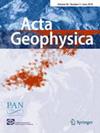高温加热后砂岩波速与孔隙度的变化
IF 2.1
4区 地球科学
Q2 GEOCHEMISTRY & GEOPHYSICS
引用次数: 43
摘要
本文报道了高温加热后砂岩的质量、孔隙度和波速的变化。砂岩标本在加热炉中暴露的温度范围为25-850℃。研究表明,在300℃以下,孔隙度和波速变化很小。在300℃以上,孔隙度迅速增大,但波速明显减小。热重分析(TGA)、差示扫描量热分析(DSC)和压汞孔隙度分析(MIP)的结果表明,砂岩孔隙度和波速的不同变化模式可能是在400 ~ 600°C之间发生的一系列变化造成的。本文章由计算机程序翻译,如有差异,请以英文原文为准。
Variation of Wave Velocity and Porosity of Sandstone after High Temperature Heating
This paper reports the variations of mass, porosity, and wave velocity of sandstone after high temperature heating. The range of temperature to which the sandstone specimens have been exposed is 25–850°C, in a heating furnace. It has been shown that below 300°C, porosity and wave velocity change very little. Above 300°C, there is a rapid increase in porosity, but the wave velocity decreases significantly. The results of thermo gravimetric analysis (TGA), differential scanning calorimetry (DSC) and mercury intrusion porosimetry (MIP) suggest that a series of changes occurred between 400 and 600°C in sandstone could be responsible for the different patterns of variation in porosity and wave velocity.
求助全文
通过发布文献求助,成功后即可免费获取论文全文。
去求助
来源期刊

Acta Geophysica
地学-地球化学与地球物理
CiteScore
3.90
自引率
13.00%
发文量
251
审稿时长
5.3 months
期刊介绍:
Acta Geophysica is open to all kinds of manuscripts including research and review articles, short communications, comments to published papers, letters to the Editor as well as book reviews. Some of the issues are fully devoted to particular topics; we do encourage proposals for such topical issues. We accept submissions from scientists world-wide, offering high scientific and editorial standard and comprehensive treatment of the discussed topics.
 求助内容:
求助内容: 应助结果提醒方式:
应助结果提醒方式:


